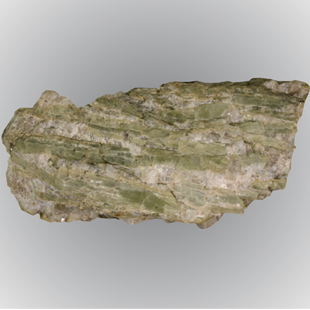Geoscience
Industrial Minerals
Commodity Summaries: Spodumene (lithium)
| Introduction Manitoba is well endowed in lithium, particularly associated with granitic pegmatites. The most prolific region in Manitoba is the Winnipeg River–Cat Lake pegmatite field, which hosts the world-class Tanco lithium-cesium-tantalum deposit, along with numerous other pegmatites that collectively define this large field. Elsewhere in the Superior province, lithium-bearing pegmatite occur at Red Sucker Lake, Gods Lake, Cross Lake, Red Cross Lake and McLaughlin Lake, and at Wekusko Lake in the Trans-Hudson orogen, indicating widespread potential for this deposit type. Spodumene, petalite and lepidolite are the most common lithium-bearing minerals in this type of deposit. Spodumene, a brittle crystalline mineral of the pyroxene group that varies in color from transparent white to yellow, gray, green and purple, is the most common mineral mined for lithium in pegmatites. Demand for lithium, particularly spodumene, increased in the early to mid-1980s when Corning Incorporated developed and marketed a new line of CorningWare products. At that time, the Tanco Mine produced a high-grade spodumene concentrate for the ceramic and specialty glass industries. Currently, lithium is in high demand driven by the raise in the manufacture of lithium batteries for use in personal electronic devices and electric or electric-hybrid vehicles. |
Spodumene, Herb Lake, Manitoba. |
|
| Applications Spodumene, as well as petalite and lepidolite, are important lithium minerals that are used in the production of ceramics, enamel, and glass. Two transparent and highly colored varieties of spodumene are used as gemstones: hiddenite, a yellow to emerald-green stone, and kunzite, which occurs as a pinkish-lilac crystal. Lithium is an essential component in nuclear weapons and nuclear-energy fuels, alloys, pharmaceuticals and it is commonly used in air conditioners and lubricants. Currently, spodumene, petalite and lepidolite are also being considered as a new source of lithium for batteries of electronics, electric vehicles and residential energy storage. Industry is thus particularly interested in processing these minerals into battery grade lithium carbonate and lithium hydroxide. Deposits and Occurrences Manitoba has many lithium-bearing pegmatites intruded in the Precambrian rocks of the Superior craton and the Trans Hudson orogen. The world-class Tanco pegmatite is the biggest known occurrence of this type with large reserves of high-grade spodumene, petalite and lepidolite. Visit the Lithium in Manitoba webpage and Lithium in Manitoba brochure for more information (available in alternate formats upon request). Suggested References Bannatyne, B.B. 1985: Industrial minerals in rare-element pegmatites of Manitoba; Manitoba Energy and Mines; Mineral Resources Division, Economic Geology Report 84-1, 96 p. Černý, P., Trueman, D.L., Ziehlke, D.V., Goad, B.E. and Paul, B.J. 1981: The Cat Lake-Winnipeg River and the Wekusko Lake pegmatite fields, Manitoba; Manitoba Energy and Mines, Mineral Resources Division, Economic Geology Report ER80-1, 216 p. plus 5 maps. Martins, T., Kremer, P. and Vanstone, P. 2013: The Tanco mine: geological setting, internal zonation and mineralogy of a world-class rare element pegmatite deposit; Geological Association of Canada–Mineralogical Association of Canada Joint Annual Meeting, Field Trip Guidebook FT-C1; Manitoba Innovation, Energy and Mines, Manitoba Geological Survey, Open File OF2013-8, 17 p. Martins, T., Linnen, R.L., Fedikow, M.A.F. and Singh, J. 2017: Whole-rock and mineral geochemistry as exploration tools for rare-element pegmatite in Manitoba: examples from the Cat Lake–Winnipeg River and Wekusko Lake pegmatite fields (parts of NTS 52L6, 63J13); in Report of Activities 2017, Manitoba Growth, Enterprise and Trade, Manitoba Geological Survey, p. 42–51. |
||



